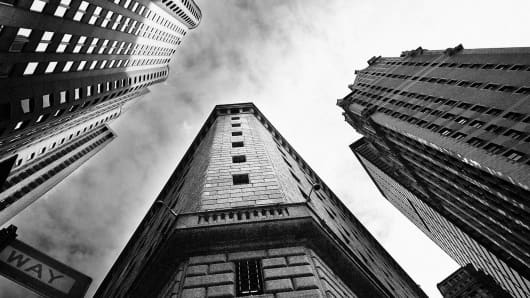That may seem obvious now but it was not obvious before the financial crisis. Here's Paul Krugman in March 2008, wondering if the Fed had become impotent:
The target Fed funds rate is now 2.25%. Everyone expects it to be reduced further; Citi economists predict that it will be down to 1% by mid-year.
But I have a possibly naive question: can the Fed really cut the Fed funds rate that far? I don't mean "can" in the sense that other concerns will give them pause; I mean literally — does the Fed really have that ability?
Bear with me while I talk this through. The Fed actually conducts monetary policy through open-market operations in Treasuries: the FOMC tells the open-market desk to buy or sell Treasuries from banks until the Fed funds rate is close to the target. Normally this puts Treasury interest rates close to the Fed funds rate, since one short-term loan to a very safe customer is a lot like another.
But right now Treasury interest rates are much, much lower than the Fed funds rate — around half a percent on both 1-month and 3-month bills. Weirdness like negative rates on repos aside (I'm still trying to wrap my mind around that one), basically the Fed can only drive Treasury rates down by about another half-point — which would still seem to leave Fed funds well above 1%.
How is it possible for the Fed funds rate to be higher than the Treasury rates? Well, one interpretation is that banks don't trust each other — not even for overnight loans. Fed fund loans, after all, are unsecured.
In other words, the Fed funds rate may be more like LIBOR than the Treasury rate — and it may be being held up by a premium similar to the TED spread.
Am I being really stupid here? Or is it possible that the fear factor will soon make it impossible for the Fed even to achieve its target on the interest rate it supposedly controls?
Now just before Krugman published this, Bear Stearns had collapsed. (Read more:
Barney Frank Defends JPMorgan Against Bear Stearns Suit.
)
Yields on short term Treasuries tumbled in response. One-month Treasury bills had a coupon equivalent of 0.35 percent. Three-month bills were at 0.62 percent. The Fed Funds rate was much, much higher, at 2.25 percent.
A lot of people saw this as reflective of a fear trade. Banks were scrambling for safe assets and avoiding lending to each other in the interbank markets, of which the Fed Funds market is a part. The gap between short term Treasury bills and the Fed Funds rate looked very much like the infamous "Ted Spread" – the difference between LIBOR and short term Treasury bills.
But there was a very important difference. The Fed Funds rate, unlike LIBOR, is simply not a market rate at all. It is a rate set by the Federal Reserve. In order to hit its target rate, the Federal Reserve simply supplies enough reserves into the banking system—buy purchasing assets in its open market operations—that the rate does what it wants it to. In most circumstances, all the Fed really has to do is promise to supply the needed reserves, and the rate responds to meet the target.
To put it differently, the reason why the Fed Funds rate was so much higher than the short term Treasury bill rate in March of 2008 was not because of fear. It was a matter of policy. The Fed had communicated that it would drain reserves by selling Treasuries if the rate rose beyond the 2.25 target. As a result, the rate stayed exactly where the Fed told it to.
But Krugman's fear of Fed impotence might not have been completely wrong-headed. The actions—or, rather, the inaction— on the part of the the Fed during much of 2008 leaves room for the possibility that the Fed itself had become paralyzed by fear.
From April 30 to October 8 -- nearly six months -- the Fed Funds rate remained stuck in place. That takes us right through the collapse of
Lehman Brothers
and AIG with no rate change. The moves down from 2 percent to 1.5 to 1 to the zero-bound all came only after Congress had passed the Troubled Asset Relief Program (or TARP). Meanwhile, the government had signaled it would stand behind failing banks, relieving some of the fear that the interbank markets were toxic. (Read more: Hedge Funds, Big Money Circle TARP's Weakest Banks.)
One way of interpreting this is that the Fed may have doubted its own ability to shift the rate downward during a period of panic. In order not to seem ineffective—or at least risk seeming ineffective—the Fed may have held off on rate cuts until we had a fiscal backstop for the banks.
The lesson here, really, should be about humility. Not only are even very smart people bad at forecasting, we have trouble understanding what is happening right before our very eyes. These days, the Fed seems like a highly effective price-setter when it comes to Fed Funds. But is my confidence that this will always be the case any more justified than Krugman's doubts back in 2008?



